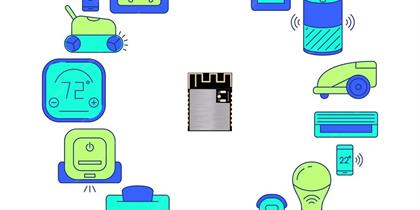

In the realm of wireless communication, Bluetooth technology has become an indispensable part of our daily lives, facilitating seamless connectivity between devices. However, the efficiency and reliability of Bluetooth communication are heavily influenced by the characteristics of the radio channel it operates in. Bluetooth Channel sounding is a technique that enables the assessment of these channel characteristics, which is crucial for optimizing performance and ensuring robust communication. This article delves into the intricacies of Bluetooth channel sounding, exploring its significance, methodologies, and applications in enhancing wireless connectivity.
The Importance of Channel Sounding
Bluetooth operates in the 2.4 GHz Industrial, Scientific, and Medical (ISM) band, which is a shared frequency spectrum. This shared nature makes the radio environment susceptible to interference from other devices, leading to fluctuations in signal quality. Channel sounding is the process of estimating the channel’s impulse response, which provides insights into the multipath propagation, attenuation, and delay spread. This information is vital for:
- Adaptive Modulation and Coding (AMC): Adjusting the modulation and coding schemes based on channel conditions to maximize data rate and minimize error rates.
- Beamforming: Steering the antenna beams towards the direction of the strongest signal paths to improve signal strength.
- Equalization: Compensating for signal distortions caused by the channel to recover the transmitted data accurately.
Methodologies in Bluetooth Channel Sounding
- Transmitter-Based Sounding: In this approach, the transmitter sends a known training sequence, which is then received and processed by the receiver to estimate the channel response. The challenge here is designing a training sequence that is robust against channel variations and interference.
- Receiver-Based Sounding: The receiver generates a sounding signal, which is transmitted back to the receiver after being affected by the channel. This method is less common in Bluetooth due to the need for a feedback link.
- Non-Orthogonal Sounding: This technique uses non-orthogonal sequences for sounding, which can provide more channel information but at the cost of increased complexity in signal processing.
- Sweep-Based Sounding: The transmitter sweeps through different frequencies within the Bluetooth band and measures the channel response at each frequency. This method is useful for identifying frequency-selective fading.
Applications of Channel Sounding in Bluetooth
- Quality of Service (QoS) Enhancement: By understanding the channel’s behavior, Bluetooth devices can dynamically adjust their transmission parameters to maintain a desired level of QoS.
- Energy Efficiency: Channel sounding can help in optimizing the transmit power, thus conserving energy and extending the battery life of Bluetooth devices.
- Interference Mitigation: By identifying the sources and characteristics of interference, Bluetooth systems can employ strategies to minimize its impact on communication.
- Network Planning and Optimization: Channel sounding data can be used to plan the deployment of Bluetooth devices in a network, ensuring optimal coverage and performance.
Challenges and Future Directions
Despite its benefits, Bluetooth channel sounding faces several challenges:
- Complexity: The process of channel estimation and the subsequent signal processing can be computationally intensive, especially for devices with limited processing capabilities.
- Latency: The time required for channel sounding can introduce latency, which is undesirable for real-time applications.
- Privacy Concerns: The transmission of training sequences or sounding signals could potentially reveal information about the devices and their usage patterns.
Future research in Bluetooth channel sounding may focus on developing low-complexity algorithms, reducing latency, and addressing privacy concerns. Additionally, the integration of machine learning techniques could enable more accurate and adaptive channel estimation, paving the way for even more efficient Bluetooth communication.
Conclusion
Bluetooth channel sounding is a pivotal technique in the ongoing evolution of wireless communication. It plays a critical role in enhancing the performance and reliability of Bluetooth devices by providing a deep understanding of the radio channel. As technology advances, the continued development and refinement of channel sounding methodologies will be essential in meeting the growing demands of wireless connectivity. With the potential for significant improvements in QoS, energy efficiency, and interference mitigation, the future of Bluetooth communication looks promising, with channel sounding at the heart of these advancements.
You Might Like Also

In the quest for cleaner and healthier indoor air, Bluetooth modules have become an integral part of modern air purifiers. These compact devices enable wireless communication between the air purifier and other systems, such as smartphones or home automation networks. By integrating Bluetooth technology, air purifiers can offer a range of advanced f Read More

In the modern landscape of wireless technology, Bluetooth modules have become indispensable components, enabling a myriad of applications that enhance our daily lives. These compact devices, embedded within a wide array of products, facilitate communication and connectivity with minimal effort. This article delves into the diverse applications of B Read More

In the realm of wireless communication, Bluetooth modules have emerged as the Swiss Army knife of connectivity, enabling seamless interaction between devices over short distances. These compact devices have become indispensable in a variety of applications, from consumer electronics to industrial automation. Bluetooth modules are the silent workhor Read More

Bluetooth Beacons are wireless transmitters that can detect the presence of mobile devices within their vicinity. In a museum setting, beacons can be placed at various exhibits to provide a wealth of information and interactive content to visitors. As a visitor approaches an exhibit, their device can receive a signal from the beacon, triggering an Read More

Bluetooth beacons have become an essential component in Indoor Positioning Systems (IPS), providing accurate location data that enhances various applications within controlled environments. In smart retail settings, beacons play a crucial role in enhancing customer experiences, optimizing store operations, and driving business insights. Read More

Bluetooth beacons are playing an increasingly vital role in Real-Time Locating Systems (RTLS), particularly within the context of warehouse management. These tiny, yet powerful devices, are redefining the way warehouses operate, offering a new level of efficiency and precision that is transforming inventory tracking and asset management. Read More












